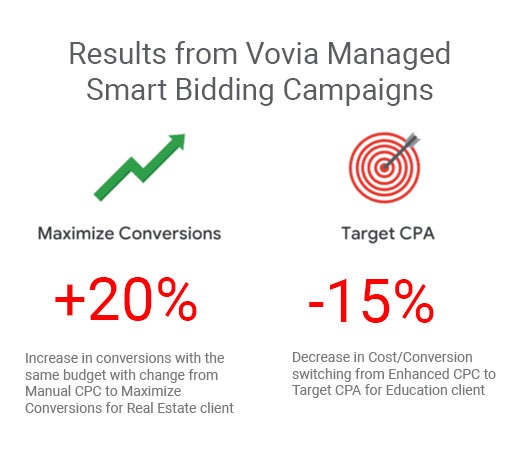Understanding Google Smart Bidding
In today’s world, automation is all around us – from manufacturing to medical procedures to personal items like your smartphone or watch. In the marketing world, automation can help us schedule tasks and make decisions, allowing us humans to do what we do best – think like a human! Google is one of the leaders at utilizing automation, and the Google Ads (previously Google Adwords) platform has evolved greatly over the years to help marketers leverage automation to get the most from their campaigns. In the last couple of years, Google has combined their love for automation with the advances in machine learning to open even more doors for improvement. Following these evolutions and after using them extensively on our campaigns, we want to dive a bit deeper into a feature that’s been increasingly utilized by our team. What Google calls Smart Bidding.

A Quick History on Bidding
At Vovia, we typically bid on Google Search and Google Display ads on a cost-per-click basis. Historically, we had to manually enter bids into the platform for all the keywords we wanted to target. There were some ways to automate this by applying conditional IF, THEN statements, but we would often need to manually make updates to bids multiple times a day to drive better performance. Fast forward, and companies started developing automation tools to help us make bidding decisions and changes to the account based on the campaign’s data. We were one of the first agencies in Canada to use Marin, a third-party tool designed to do this. Since then, all sorts of third-party tools have been introduced, so Google jumped on this train and incorporated the feature directly to the Google Ads platform and made it available to all advertisers. Today, all Smart Bidding needs is a daily budget, a chosen bidding strategy, and some historical data to work its magic.
What is Smart Bidding All About?
Smart Bidding is an advanced machine learning algorithm that determines bids for you in place of manually setting bids for your keywords or product groups. Google does this by leveraging historical data in the account and uses contextual signals to make decisions on bidding (and sometimes even targeting) It does all the repetitive, calculated tasks for us so that our specialists can spend more time doing strategic things that computers can’t do, like moving budget due to seasonality, changing ad copy to combat competition, or create a pivoting strategy due to a global pandemic.
What Factors Does Smart Bidding Take Into Consideration?
Based on what objective you choose the algorithm to optimize towards, there are many types of signals that it considers when making decisions, much like we would if we were doing it manually:
- Device
- Physical Location
- Location Intent
- Time of Day
- Remarketing List
- Ad Characteristics
- Interface Language
- Browser
- Operating System
- Demographics
- Query
What can Smart Bidding Optimize Towards?
There are several Smart Bidding strategies you can use, depending on the objective of your campaign. Perhaps multiple strategies apply depending on the campaign you’re running. Examples of these strategies are:
- I want to drive as much qualified traffic to the site → Maximize Clicks
- I do not want to pay more than $X for a conversion → Target CPA
- I want to maximize conversions at the set budget I have → Maximize Conversions
- I want to maximize the return on ad spend because my products have very different revenue points → Maximize ROAS

The Catch: Feeding the Machine for Smart Bidding
While Smart Bidding can be used for most campaigns, there are situations where it works best. One of my team members likes to use the phrase “feeding the machine”. What she means by this is that the algorithm works better when it has more data to analyze. Especially for conversion-based bidding strategies, you need at least 30-50 tracked conversions in the last month to truly get the most out of Smart Bidding. Otherwise, it may make bad decisions due to low amounts of data, and be worse off than if you manually managed the bids.
Closing Thoughts
Smart Bidding is designed to save marketers time by making calculated decisions based on your set objective and signals from your campaign performance. Choosing the right strategy may not be obvious at first (even for us), which is why we test multiple bidding strategies and evaluate performance over time across our clients. What works for one client’s campaign may not work for another. Doing these tests gives us the historical data to benchmark new innovations when the come up, continually raising the bar.
Have you run Smart Bidding Campaigns? If so, what has your experience been? Let us know in the comments!
